An introduction to one of Norway's most iconic brands. Love it or hate it, the frozen pizza brand Grandiosa is impossible to ignore. Here's the full story.
National dish, marketing success story, culinary abomination; Pizza Grandiosa can be described in a variety of ways. What is undeniable though is that it is loved by many Norwegians, and even its detractors are liable to buy it from time to time.
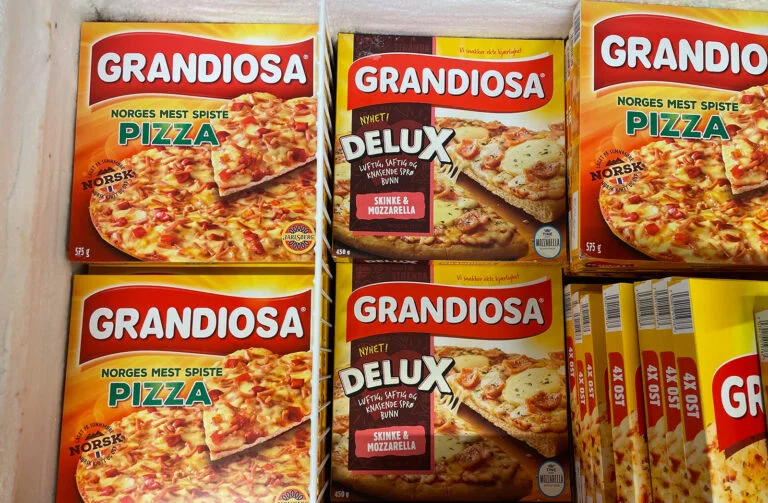
If you are at all familiar with contemporary Norway, you have most certainly heard of Pizza Grandiosa. What exactly makes this frozen pizza brand so special? What does it taste like? How did it come about and why is it so popular?
In this article we tell you everything there is to know about Grandiosa. From its humble beginnings to its rise to the summit.
Pizza in Norway: an exotic dish
Pizza is so omnipresent in Norway today that it’s easy to forget how “exotic” the dish was in 1980, when Grandiosa was launched on the market.
According to Grandiosa’s origin story, Ivar Moss, the director of the factory where the famed pizza would end up being produced, accepted his boss’ request to start production without even knowing what pizza was exactly.
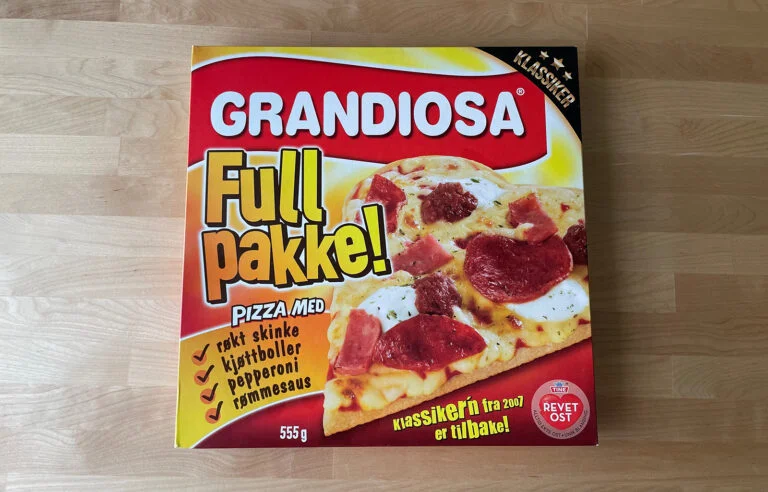
Indeed, in 1980, many Norwegians had yet to have tried pizza. Peppes Pizza, one of the main pizza restaurant chains in the country, only opened its first location in 1970.
At the time it was Norway’s very first pizza restaurant – but it took a while for the dish to find its place on Norwegian tables.
Pizza Grandiosa: the original recipe
Today there are many varieties of Grandiosa but the “original” remains hugely popular. While the exact recipe of the original is of course a secret, several facts are well-known. The crust is wheat-based and was initially imported ready-made from Canada.
Atop the crust is a simple tomato sauce, topped with some “pizza meat”. This term refers to a special blend containing 40% Norwegian beef, as well as water, soy protein, spices and preservatives. Sounds delicious, no?
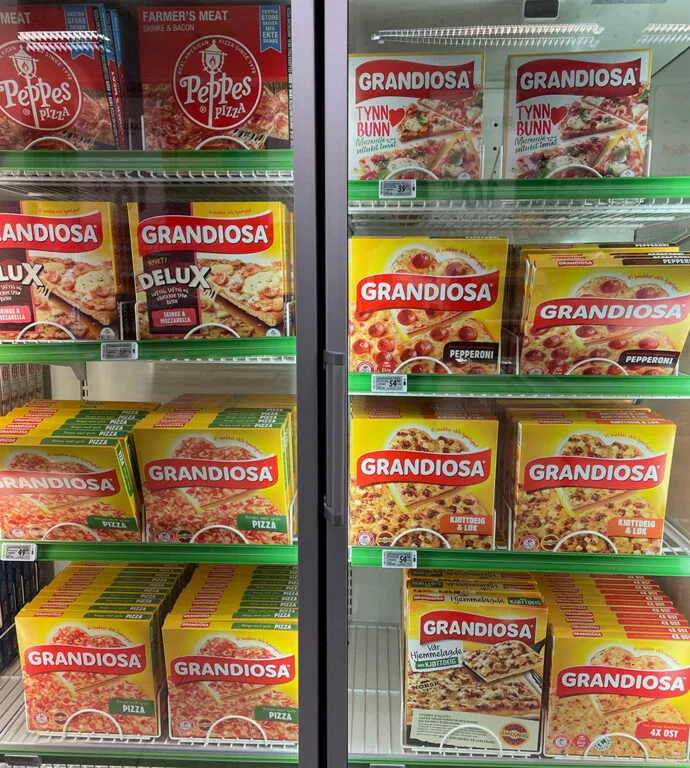
On top of the “pizza meat”, you’ll find Jarlsberg – a Norwegian cheese exported worldwide and reminiscent of a mild Swiss cheese – and diced red bell pepper.
The combination of Jarlsberg and bell pepper is said to be a nod to a traditional variant of the Norwegian “brødskive”: a slice of bread garnished with mild cheese and red bell pepper.
What does Grandiosa taste like?
Describing Grandiosa to someone who has never tasted it is relatively easy. Let’s start with the crust: if you are familiar with the rising crust frozen pizza that appeared in North America in the mid-1990s, and rivals restaurant pizza in texture and taste, you must put every mental reference to that type of crust out of your mind.
Grandiosa pizza crust definitely doesn’t rise. Like old-school frozen pizza crust, it is chewy and unexciting. Maybe Grandiosa crust needs to be added to the list of shameful Canadian exports, between Justin Bieber and Crocs.

Disclaimer: there is one variety of Grandiosa featuring rising crust (Grandiosa Nybakt), but this description is concentrating on the original variety. It was the only one in existence between 1980 and 2001, and to this day is the best selling of all Grandiosa varieties.
The tomato sauce used with Grandiosa is quite mild. It is difficult to know what it is made of exactly, but it tastes like watered-down tomato paste.
The meat, as we have mentioned above, consists of only 40% meat. Red bell pepper plays the role of the dish’s only vegetable, and tastes exactly as you would expect.
The cheese is actually quite nice. Topping a pizza with a swiss-like cheese is unusual, and does not lead to the type of stretchy, melty effect that one gets with mozzarella, but the flavour is quite rich.
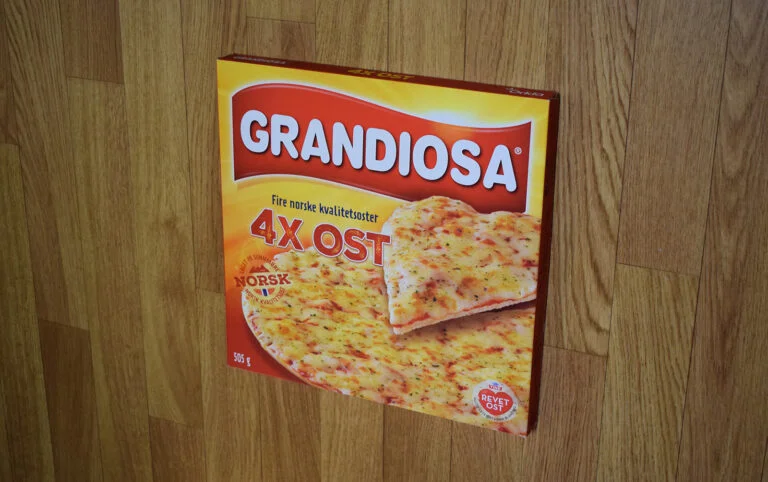
That being said, the flavour of Jarlsberg alone is not enough to rescue what is in essence an incredibly bland dish.
This blandness is confirmed by the widespread habit Norwegians have of dousing Grandiosa slices with ketchup, sprinkling them with piffi-krydder – a flavour-enhancing, salt-based, off-the-shelf spice blend – or both.
Why is Grandiosa so popular?
So Grandiosa is bland – even some of its fans will agree to that – but why then has it sold 600 million units since its launch in 1980? Coming to a decisive conclusion is difficult but there are several possible answers.
First the elephant in the room: anyone who has sampled Norwegian cuisine knows that blandness is not necessarily a bad thing from the perspective of local palates.
The country’s actual national dish, fårikål, is a slow-cooked dish of mutton and cabbage seasoned with only salt and pepper.
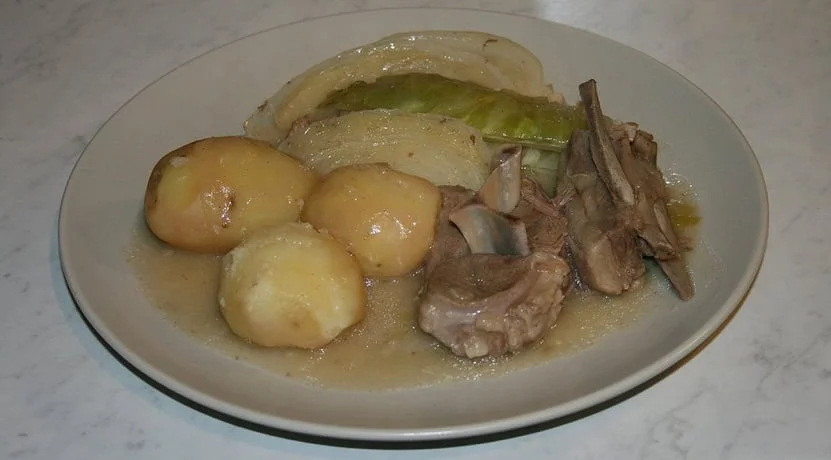
Christmas dinner hits like ribbe (roast pork belly with crackling) and pinnekjøtt (dried mutton ribs, steamed for several hours) are similarly devoid of spices in their most traditional incarnations. It should then not come as a huge surprise that the top-selling frozen pizza lacks in flavour.
Another possible explanation for the rise in popularity of Grandiosa, at least initially, is the cool-factor it carried, as a Norwegian version of an exotic, foreign food. Sushi experienced a similar rise in the country over the past 15 years.
Just like eating sushi in 2008 in Norway was a way to let others know what a cool and worldly person you were, eating Grandiosa in 1980 was a convenient and easy way to put something exotic and new on your dinner table.
A final factor that should not be neglected is the excellent marketing strategy used by the makers of Grandiosa. Let’s dive into that now.
Grandiosa: a marketing success story
From the very beginning, advertisement was key to Grandiosa’s success. Already in 1984, the brand launched a TV advertisement featuring the women’s national cross-country ski team.
In December 1996, a Christmas advertisement was launched featuring a popular band. It is shown on TV every Christmas season, having become something of a tradition for many.
Ten years later, in 2006, the song Respekt for Grandiosa topped the charts for eight weeks. It was the first time that a song purely intended for advertisement made the charts in the country.
Another way in which Grandiosa ensures its dominance is through a constant downward pressure on prices. It’s usually possible to stock up on cheap Grandiosas once every few weeks.
It should be mentioned though that store brands are often cheaper (and objectively not any worse) than Grandiosa.
Alternatives to Grandiosa in Norway
If you come to Norway and have not had the occasion to try Grandiosa yet, you should definitely give it a go. Having low expectations and being quite hungry will increase your enjoyment.
If you spend an extended period of time in Norway and are in need of a simple meal, frozen pizza is a practical solution but be aware that there are better offerings on the market than Grandiosa. Here is a short list.
Big One
Big One is another brand owned by Orkla, the company behind Grandiosa. Together, the two brands dominate the market. Big One styles itself as an “American style” pizza, and has a thicker crust.
If the crust is marginally better, flavour-wise, the pizza is generally also quite bland, although a new “Smoking hot BBQ chicken” variety seems promising.
Dr Oetker
Dr Oetker has many varieties, notably the Casa di Mamma one that was the first frozen pizza with a rising crust to be widely available in Norway. The flavour and quality of the products seem to have helped Dr Oetker gain ground over Grandiosa.

Presumably in response to Dr Oetker’s progress, Grandiosa has launched its own line of rising crust pizzas, and – more recently – thin crust pizzas similar to the Dr Oetker Ristorante series.
Peppes Pizza
Norway’s very first pizza restaurant made inroads into the frozen pizza markets recently. The Grandiosa/Big One dominance is still a fact, but Peppes managed to carve itself a piece of the cake.
The chain also signed a deal with the country’s Circle K fuel stations, to serve its products to motorists on a takeaway basis.
Store brands
Coop, Rema 1000 and others are also trying to take a share of the frozen pizza market. Coop, for example, currently offers seven different varieties under its own brand.
Are you a fan of frozen pizza? Have you ever tried Grandiosa? If you haven't, would you, based on our description? Tell us what you think in the comments…


Oh the memories,worked in the original Peppes West End in 1974 behind the cocktail bar.At that time the place was a bistro with an extensive non pizza menu and ,of course the pizza parlour, an International crew of many nation worked there,in my case a Scot was in charge of the bar !
Hi harry, in English for det er lettere because of alphabet. Hi fra Anne Jordan i USA. Have just read this article and everything is a total fabrication of what happened in Norway and the start of pizza. You must have worked in the headless horse bar. It has been fascinating to follow the pizza business and ola Normands love of same. In my opinion it happened only because we owners of peppes created a very good pizza for Norwegian. It sure has exceeded more than we expected, as peppes now is 52 years old, I am still very proud of what we created. So fun to know you worked at western. Best wishes Anne Jordan
I am a Norwegian living abroad. My first visit to Peppes was in Oslo in 1982. I am still a fan of Peppes and visit once every two years when I have the opportunity. Where I live we have plenty of Italian restaurants so this has become my new reference. The Grandiosa is Ok for an evening with Netflix but certainly nothing special. People in Norway eat a lot of processed food home. I guess modern life style and lack of rural restaurants is some of the explanation.